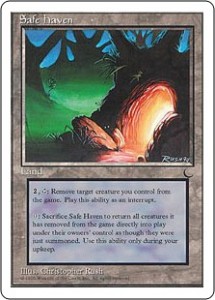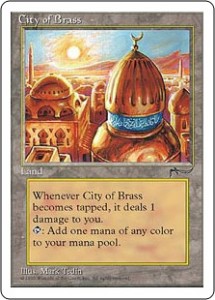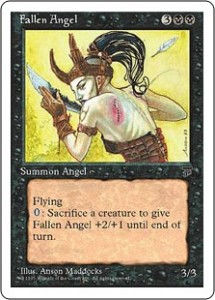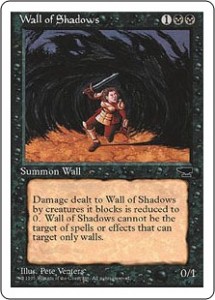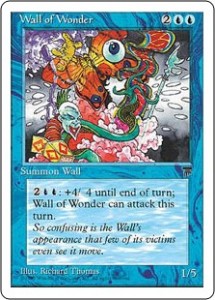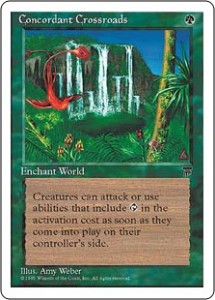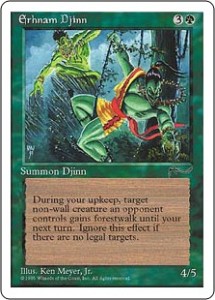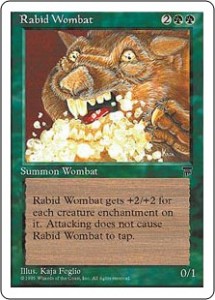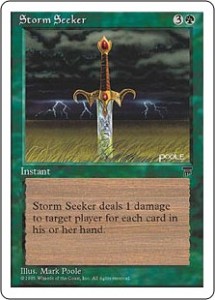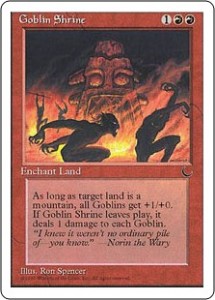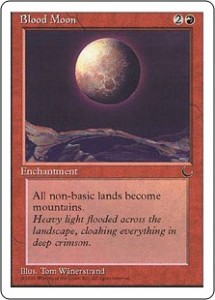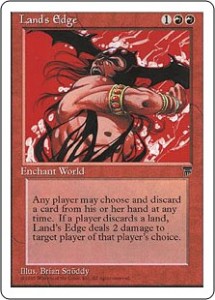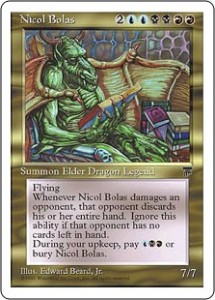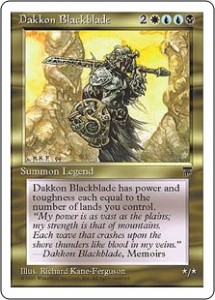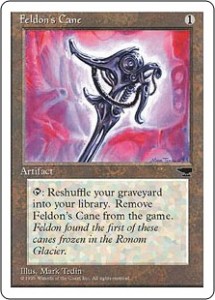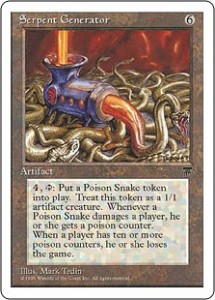
An Introduction to Chronicles
Chronicles was designated as an extension of Fourth Edition and only included reprints from Magic: The Gathering’s first four expansion sets; Antiquities, Arabian Nights, Legends and The Dark.
It has been said that Chronicles was printed to satisfy the market demand of players who had been unable to buy as much of the first four expansions as they wished, or who were new players and missed those expansions entirely. This appears to be true, because the effect Chronicles had on the game was to open up those older cards to newer players, as well as, integrate those older reprinted cards into the current tournament structure of what was then Type II.
Released in 1995, Chronicles was a small set that numbered only 125 total cards and consisted of 21 from Antiquities, 14 from Arabian Nights, 71 from Legends and 19 from The Dark.
The color breakdown was even across the board with 14 Black cards, 14 Blue cards, 14 Green cards, 14 Red cards, 14 White cards, 20 Multicolor cards, 21 Artifacts cards, and 14 Lands. The set contained 54 Commons, 71 Uncommons and 50 Rares, and along with Alliances was the only other set to have 12-card booster packs instead of the standard 15.
By releasing reprinted cards back into the libraries of players, Rampage came back into fashion for a short time. For those of you who are unfamiliar with this outdated ability, you’ll need to dive deep back into Magic: The Gathering’s rule book; currently item 702.22 is Rampage.
Rampage is a triggered ability. “Rampage N” means “Whenever this creature becomes blocked, it gets +N/+N until end of turn for each creature blocking it beyond the first.”
Chronicles also gave a second life to a specific kind of Summon Legend from Legends; the Elder Dragon Legends. There were five, all huge creatures, all with flying and other abilities, all 7/7 and all expensive at a cost of two colorless Mana and six other Mana consisting of three different colors.
Although from the breakdown of sets that comprised this set of reprints, one might think of Chronicles as Legends light, but the standout cards of the set weren’t all reprints from the legends, in fact, of the cards that were widely used, it’s fairly balanced across the sets.
The Lands of Chronicles: Cities, Havens, Powers, Towers and Mines
There were only five lands reprinted in Chronicles and all are interesting as far as their place in the history of Magic, but two stand above the others as the most useful.
The Lands are, City of Brass from Arabian Nights, Safe Have from The Dark and Urza’s Mine, Urza’s Power Plant and Urza’s Tower all from Antiquities.
The Urza’s set; the Mine, Power Plant and Tower, are very interesting in that they were reprinted with some of their alternate artworks, so each card had three of it’s four Antiquities version reprinted in Chronicles. If you’re not familiar with them, they each add one colorless Mana to your Mana pool, however if you control at least one of all three, then the Mine and the Power Plant add two Mana, while the Tower adds three Mana to your Mana pool.
During Antiquities and again when these Urza’s lands were reprinted in Chronicles, “the Artifact deck,” was tried and tried again. At the heart of the deck were these lands, and although I never saw one that worked consistently, that doesn’t mean I haven’t had thoughts of trying to create one myself. (Author’s note: I’m sure that a well balanced Artifact deck can be created and be competitive.) If you want to try these lands out, they were reprinted in Fifth, Eighth and Ninth Editions, as well.
Safe Haven from The Dark was, and still very much is, a remarkable card. It’s not a Mana-producing land, but it doesn’t need to be. It could have been an Artifact, but as a land it’s a little harder for opponents remove. In the Fallen Empires edition of the Old School Magic series, I spoke about Safe Haven’s combo with Seasinger. There are plenty of other card combinations where having the ability to remove your creatures from harms way and then return them to play is extremely useful.
City of Brass was the “ultimate pain land” although until the Ice Age pain dual lands came out, it was just called “City.” City of Brass was a staple in any deck that contained three or more colors. In truth, I used to throw four into my straight Green decks with two Disintegrates or Fireballs or any other red X casting cost direct damage, because if I drew it and had a City out, it was something that my opponent wouldn’t have seen coming. City of Brass was later reprinted in Fifth, Sixth, Seventh and Eighth Editions.
The Color Black in Chronicles: Angels. Demons and a Wall
The reprinting of certain Black cards in Chronicles gave back some power creatures to an already powerful stable of creatures in Black. Fallen Angel, hell’s Caretaker, Shimian Night Stalker, The Fallen, The Wretched and Wall of Shadows were the standouts.
Fallen Angel was a Summon Angel from Legends that found a rebirth of sorts by being printed after Fallen Empires’ Breeding Pit. The 3/3 flyer had the ability “0: Sacrifice a creature to give Fallen Angel +2/+1 until end of turn.” With the advent of Breeding Pit, Fallen Angel was a creature to fear, if a Breeding Pit was in play. Every turn, Breeding Pit was pumping out creatures that could be sacrificed to the Angel and they could be saved to really pump up the Angel to a 11/7 with just four sacrificed Thrull tokens, that’ll take out most of the flyers that existed at the time and live to tell the tale.
Hell’s Caretaker also was given the same benefit that Fallen Angel had in being reprinted after Fallen Empires’ Breed Pit. Hell’s Caretaker’s ability is, “TAP: Sacrifice a creature to take target creature from your graveyard and put it directly into play as though it were just summoned. Use this ability during your upkeep.” In fact, because Breeding Pit’s tokens were put into play at the end of your turn, as long as you had the Breeding Pit in play, you could keep returning a creature to play from your graveyard every turn.
Shimian Night Stalker was a 4/4 that could take a hit from any attacking creature should you not want to take it yourself and The Fallen dealt damage to opponents it had already damaged during your upkeep. Yawgmoth Demon was a summon Demon with Legend-like abilities and upkeep and The Wretched allowed you to gain control of creatures that blocked it, but it was a wall, of all things, that really boosted the defenses of a Black deck.
Wall of Shadows was a great defense and with a Dark Ritual it was a first turn defender. Wall of Shadow’s ability was “Damage dealt to Wall of Shadows by creatures it blocks is reduced to 0. Wall of Shadows cannot be the target of spells or effects that can only target walls.” Granted it was a target for Lightning Bolts, but it meant that those Bolts weren’t killing you or other creatures.
The Color Blue in Chronicles: Walled in by more Control
Blue’s copy cat and control tendencies were boosted by the selection of reprints in Chronicles.
Boomerang’s return to the printed world of Magic was widely celebrated by players of Blue. Two Blue Mana for an Instant to “Return target permanent to owner’s hand.”
Yes please, can I have some more?
Why sure, how about a Remove Soul for one colorless and one Blue Mana you can “Counter target summon spell.” These reprints were great additions to Blue’s already powerful arsenal of control spells, and they were both reprints from Legends.
Dance of Many was a Clone of sorts, only it was an Enchantment and had an upkeep cost. Copying a creature is one thing, but what about stealing your opponents stuff? That was covered with Juxtapose, by swapping with opponent the highest casting cost creature and artifact you have with the highest casting cost of those your opponent has.
That wasn’t the only control, Teleport allowed you to have an unblockable creature until end of turn and Puppet Master allowed you to return a creature from the graveyard to owner’s hand and for an additional cost, Puppet Master itself. Again, as with Black, it was a few Walls that got some love by being reprinted in Blue; Wall of Vapor and Wall of Wonder.
Wall of Vapor was the Blue Wall of Shadows only it could be targeted by spells and abilities that target walls. Wall of Wonder on the other hand was an entirely different beast.
Wall of Wonder was a 1/5 Wall that could be transformed into a 5/1 with the ability to attack. It’s not a sleeper card, your opponent knows it’s out and what it can do, but you have your choice to use it for an offensive whenever it’s beneficial to you, otherwise, it’s just a 1/5 Wall and that’s fine, too.
The Color Green in Chronicles: More than just Elves
Green received the biggest boost in Chronicles. Small useful creatures; Emerald Dragonfly, Ghazban Ogre and Scavenger Folk, combined with Rabid Wombat and Erhnam Djinn and powerful spells like Storm Seeker, Cyclone and Concordant Crossroads returned Green to a time when it was more than just Elves.
Concordant Crossroads is an interesting reprint from Legends, in that it is an “Enchant World” that gives all creatures haste. “Enchant World” doesn’t exist as an Enchantment type anymore. Cyclone was a permanent Pestilence that got bigger each turn, until it was too expensive to upkeep and Revelation, also and “Enchant World,” made “All players play with the cards in their hands face up on the table.”
Two of the small useful creatures were used more than the others. Ghazban Ogre, whose allegiance was with the player who had most life was a great first turn play and Scavenger Folk as a 1/1 that could be sacrificed to “destroy target artifact” was a great first turn play as well.
The Scavenger Folk was put into decks to prevent Black Vise, The Rack, Millstones, Icy Manipulators and many other commonly used Artifacts, from getting combos and abilities out early to gain a stranglehold on the game.
But there were three huge reprints in Chronicles for Green that stood miles above the rest; Erhnam Djinn, Rabid Wombat and Storm Seeker.
The reprint of Erhnam Djinn, from Arabian Nights, gave rise to the Erhnageddon deck. Using Green’s staple Llanowar Elves to get fast Mana, cast the Erhnam Djinn and then Armageddon, so the Erhnam’s upkeep of giving an opponent’s creature Forestwalk was rendered useless. This deck was made with many tweaks, but that was the base of every incarnation of the deck. When Erhnageddon was built well and built balanced, it was a formidable deck for any opponent that ran into it’s path.
The comeback of Legends’ Rabid Wombat gave rise to the Wombat Deck. It wasn’t full of wombats, it was full of Enchantments. Rabid Wombat was a 0/1 that had “Rabid Wombat gets +2/+2 for each creature enchantment on it. Attacking does not cause Rabid Wombat to tap.”
Put a Lure, Venom and Regeneration on the Rabid Wombat and you have a 6/7 that can wipe your opponents creatures clear off the table. For good measure, you can put any other creature enchantment on it, to boost it even more.
I have a Rabid Wombat deck and it is pure fun to play. It doesn’t work all of the time, as it is a fairly slow deck, even in Green, but it is pure fun. You can really make it your own, I’ve seen many variations on this deck, but they all include the Lure, Venom, Regeneration combo with the Wombat.
Storm Seeker, a reprint from Legends, was one of the few Green direct damage Instants in the game and when it was reprinted from Legends in Chronicles, there was much rejoicing from players of Green. “Storm Seeker deals 1 damage to target player for each card in his or her hand.” It’s simple and effective and if played early on or after a big draw by an opponent can be downright deadly.
Erhnam Djinn, Rabid Wombat and Storm Seeker allow me to make the statement that Green was the color that benefited the most from the selection of reprints for Chronicles. Yes, other colors gained some powerful cards, but no color had three cards that had more influence on the game after the reprints of Chronicles were available in booster packs than Green. I truly believe that.
The Color Red in Chronicles: Goblins and the Blood Moon at Lands Edge
As with many sets prior and those to come, Red’s staple tribe Goblins was enhanced by Chronicles, with the reprint of Goblin Artisans, Goblin Digging Team, Goblins of the Flarg and especially with Goblin Shrine.
Aladdin gave Red some control, Blood Moon was a powerful Enchantment coming on the heels of Ice Age, Lands Edge was extremely useful and Primordial Ooze was simply a fun card.
As I said, tribal Goblin decks were benefited by Chronicles with reprints from Antiquities and The Dark, but none was more helpful than Goblin Shrine. Goblin Shrine was an Enchant Land that “As long as target land is a mountain, all Goblins get +1/+0. If Goblin Shrine leaves play, it deals 1 damage to each Goblin.” The drawback, that it would be destroyed, was a with risk worth taking for the upside of giving all of your Goblins a boost in power.
Blood Moon, an Enchantment that made all non-basic lands Mountains, was a game changer in the wake of Ice Age’s Pain and Slow Lands. In fact, because of it’s reprinting in Chronicles, Blood Moon was more effective because of the card library, in play, in Type II at the time, when compared with the available non-basic lands and their use at the time of it’s original printing in The Dark.
Land’s Edge was an Enchant World where “Any player may choose and discard a card from his or her hand at any time. If a player discards a land, Land’s Edge deals 2 damage to target player of that player’s choice.” There are two things that this card is good for.
One is that many Black cards work with cards from the graveyard and if a card allows you to just discard cards at will, you can get that big creature with an Animate Dead much sooner than normal.
Second, at some point in the game, your weenie Goblin or Elf deck will not require any more land, so why not use it to hit your opponent. That land probably won’t do much for your already burgeoning Mana Pool and it doesn’t do any good in your hand. Interestingly enough, Land’s Edge was replaced by Seismic Assault, which was printed in Exodus and only effects you, so you’re opponents can’t hit you by discarding a Land.
Primordial Ooze, is an interesting creature. “Must attack each turn if possible. At the beginning of your upkeep, put a +1/+1 counter on Primordial Ooze. At the end of your upkeep, pay X, where X is equal to the number of +1/+1 counters on Primordial Ooze, or Primordial Ooze deals X damage to you. If Primordial Ooze deals damage to you in this way, tap it.”
The reason I and most enjoy Primordial Ooze, is the value of boosting it and giving it to your opponent. Thus putting the onus of upkeep and the possibility of constant damage during one’s upkeep on your opponent. In fact, the Legends Artifact Gauntlets of Chaos, which was also reprinted in Chronicles, makes this very possible.
The Color White in Chronicles: Lepers, Witches and Sphinxes, Oh My
White in Chronicles wasn’t boosted in power as much as the other colors. Sure there were plenty of useful cards, but to me there are only four of note; Abu Ja’far, Angelic Voices, Petra Sphinx and Witch hunter.
Abu Ja’far’s reprinting, from Arabian Nights, gave White a very strong first turn defensive creature. Abu Ja’far is a 0/1 summon Leper, with a great ability; “if Abu Ja’far is put into the graveyard from play during combat, bury all creatures blocking or blocked by Abu Ja’far.” Everything for this Leper is a suicide mission, being that he’s only a 0/1, but you can take out the intended target, if you keep it back as a blocker.
Angelic Voices, a reprint from Legends, was a more expensive Crusade. It was an enchantment that only worked to give your creatures the +1/+1, if you only control creatures that are White or Artifact. Although, the cost was higher it was better than Crusade, because it only effected your creatures and not all White creatures.
Petra Sphinx was an expensive 3/4 creature version of Millstone, only weaker. The ability Petra Sphinx had was “Tap: Target player names a card and then turns over the top card of his or her library. If it is the card named, put it into that player’s hand. Otherwise, put it into the player’s graveyard.” The Sphinx was expensive too, at two colorless and three White Mana, but the upside was unlike Millstone, it was a Tap ability and not a Tap and Mana cost ability.
Witch Hunter is the most useful creature to come out of Chronicles reprints from The Dark. For two colorless and two White Mana you get a 1/1 with two great abilities. One, is “TAP: Witch Hunter deals 1 damage to target player.” Two, is “one colorless, two White Mana and TAP: Return target creature any opponent controls to owner’s hand.” The first ability is nice, but the second ability isn’t to shabby.
Targeting any opponent’s creature to Boomerang them back to their hand over and over again, is a great proposition, provided you can keep the 1/1 Witch Hunter alive, long enough to annoy your opponent. I’m sure once you bounce back a creature for the second time, the Witch Hunter becomes a target.
Gold in Chronicles: Rise of the Legends and Elder Dragons Legend, Too
All of the Gold creatures in Chronicles are Legends from Legends, but there is a subset of them that stands apart as they are the Elder Dragon Legends. They all have expensive casting costs, but are all useful if they can be cast.
The five Elder Dragon Legends are Arcades Sabbath, Palladia-Mors, Vaevictis Asmadi, Nicol Bolas and Chromium. All of them could fly, all had upkeeps and all had additional abilities. The top of the heap in terms of additional abilities was Nicol Bolas who had, “whenever Nicol Bolas damages an opponent, that opponent discards his or her entire hand. Ignore this ability if that opponent has no cards left in had.”
The other Legends had varying abilities and ranged from 1/2 to */* for power and toughness. As far as abilities go, Rubinia Soulsinger, Nebuchadnezzar, Xira Arien, Dakkon Blackblade and Stangg were ahead of the game.
Rubinia Soulsinger allowed you to Tap her to gain control of target creature, although she was only a 2/3, so she could easily be felled by a Lightning Bolt. Nebuchadnezzar allowed you to name a card and have opponent reveal X cards from his or her hand, if any of the named card was revealed, they are discarded. This is the anti Couterspell, if you can get it out first. Xira Arien gave you the ability to draw one card and Stangg was a 3/4 that when summoned also summoned a 3/4 Twin Token into play.
Dakkon Blackblade was the */*, mentioned earlier. This Legend had a power and toughness equal to the number of Lands you control. Considering that Dakkon cost two colorless, one White, two Blue and one Black Mana, when you could cast him you would probably have at least four lands, if you were aided by a Dark Ritual. But of course, that number would only get higher as the game wore on.
The Artifacts of Chronicles: Feldon’s Cane and a Whole lot more
The committee, at then Wizards of the Coast, that selected the Artifacts for reprint in Chronicles changed the Type II tournament format at that time with one extremely useful artifact; Feldon’s Cane. The Cane was immediately restricted in tournament play, but it was a staple card for any and every deck back in the day, but it was far from the only card that was selected for reprint that changed the landscape of Magic.
Tormod’s Crypt and Fountain of Youth found new life in Chronicles and Gauntlets of Chaos, Serpent Generator, Triassic Egg, Voodoo Doll and Jeweled Bird, also had impacts on the game.
Tormod’s Crypt and Fountain of Youth, both from The Dark and cost 0, were easy additions to most decks, because they were useful to many different types of decks.
Gauntlets of Chaos and it’s ability to allow you to exchange ownership was used with small cards build up with upkeeps, such as Primordial Ooze and with big cards with massive upkeeps, such as Ice Age’s Illusions of Grandeur. This made Gauntlets of Chaos the focus of many deck templates. But on it’s own, it never worked, it always needed to be an addition to another deck theme.
Serpent Generator was, a very well could still be, the greatest token generating Artifact in the game. It didn’t just create Snake tokens, it created Poison Snake tokens that could give opponents poison counters, an often overlooked and very successful way to defeat your opponent.
Triassic Egg and Voodoo Doll were both extremely fun to play and throw into decks that may be a bit slow and it was very surprising that Chronicles included the ante card Jeweled Bird, as at this time ante cards were disappearing from the printed ranks.
In Conclusion Chronicles
To be fair, Chronicles is a set unto itself. By comparison to the sets that have come since, a set of reprints that contains cards that are less than a year removed from the market seems ridiculous. But at that time, Chronicles filled a void. It’s possible to argue that it flooded the market as far as the sets it reprinted cards from, but it did more good than bad. This was back in 1995, when Magic wasn’t the widespread game it is now.
Sure, it allowed newer players to access cards they wouldn’t have normally played with, but it also allowed some older cards to have a new life, because of the cards printed since their original printing and because it gave them playability in current tournament formats at the time.
Chronicles broke the mold, but at the same time, it wasn’t supposed to be a mold. I see it as a highly successful set that accomplished what it set out to do. It helped expand Magic to the newer players at that time and with that in mind, I call Chronicles a success.



